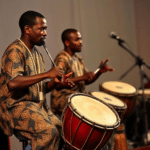The Evolution of the Piano: A Journey from Harpsichord to Grand
Imagine attending a concert. The pianist sits, and their fingers dance across the keys. Each touch brings a different feeling. This magic comes from a long journey! It’s a journey from a simple instrument to the powerful piano we know now.
The piano’s story starts with the harpsichord. It was popular, but it had limits. The piano’s evolution showcases advancement. It also shows our desire for more control and better sound.
The Precursor: Evolution of the Piano Understanding the Harpsichord
Before the piano, there was the harpsichord. How did it make its sound? It’s important to understand this to see why the piano was such a big deal.
How the Harpsichord Works: Plucking Strings
The harpsichord makes sound by plucking strings. A small pick, called a plectrum, does the plucking. When you press a key, the plectrum hits the string. This makes a bright, clear sound.
The piano is different. It uses hammers to hit the strings. This gives a richer, more powerful sound. The action is quite different, the harpsichord plucks but pianos strike.
Limitations of the Harpsichord: Dynamics and Expression
The harpsichord had a problem. You couldn’t change the volume much. Hit a key soft or hard, and it sounds about the same. This limited what composers could do.
Think of Bach’s harpsichord pieces. They’re beautiful, but they don’t have big changes in volume. Composers knew the harpsichord’s limits. They wrote music to fit what it could do.
Cristofori’s Breakthrough: The Invention of the Piano
Bartolomeo Cristofori changed everything. He invented the piano around 1700. This was a huge step forward. It allowed for something that the harpsichord couldn’t do.
The “Gravicembalo col piano e forte”: A Revolutionary Concept
Cristofori called his invention “gravicembalo col piano e forte.” This means “harpsichord with soft and loud.” It showed what was special about his new instrument. You could play quietly (piano) or loudly (forte).
His early pianos had hammers that hit the strings. The force of your touch controlled the volume. It was revolutionary for its time. This was a game changer for musicians and audiences!
Challenges and Innovations in Early Piano Design
Cristofori faced challenges. Making a hammer action that worked well was tough. He had to figure out how to make the hammer hit the string and then get out of the way quickly.
He invented the escapement mechanism. This let the hammer fall back after hitting the string. It also allowed the string to ring freely. These problems that Cristofori solved were critical.
Key Developments in Piano Technology
The piano didn’t stop with Cristofori. People kept improving it. These changes made the piano even more expressive and powerful.
The English Action vs. the Viennese Action
Two main types of piano actions emerged. There was the English action and the Viennese action. The English action was stronger and louder. The Viennese action was lighter and more responsive.
The English action used hammers that were covered in leather. This made for a fuller sound. The Viennese action used lighter hammers. Composers like Mozart favored the Viennese action. They preferred its delicate touch.
The Introduction of Iron Frames: Increasing String Tension
Early pianos had wooden frames. These frames couldn’t handle much string tension. The introduction of iron frames changed this. Iron frames could support much higher tension.
With stronger frames, piano makers could use thicker strings. Thicker strings meant a louder, richer sound. The iron frame was a major step in piano development.
Pedal Innovations: Expanding Expressive Capabilities
Pedals added even more to the piano’s sound. The sustain pedal lets notes ring on even when you lift your fingers. The una corda pedal softens the sound by only hitting one string.
These pedals gave pianists more control. They could create new effects and emotions. Composers began to use pedals in their music. These additions made the piano more versatile.
The Rise of the Grand Piano
The grand piano became the most popular type of piano. Its design allowed for a longer soundboard and longer strings. This created a bigger, more resonant sound.
The Modern Grand Piano: Standardized Design and Manufacturing
Today’s grand pianos have a fairly standard design. They have a cast-iron frame, a large soundboard, and a complex action. Modern manufacturing makes them more consistent.
Companies like Steinway helped to standardize piano design. They focused on quality and precision. Their pianos became the standard for concert halls.
Concert Grand vs. Parlor Grand vs. Baby Grand: Sizes and Applications
Grand pianos come in different sizes. Concert grands are the largest. They’re used in concert halls. Parlor grands are smaller and fit in larger homes. Baby grands are even smaller, and great for smaller rooms.
The size affects the sound. Larger pianos have a bigger, fuller sound. They also cost more. The right size depends on your needs and space.
The Piano’s Enduring Legacy and Future
The piano has had a huge impact on music. It’s used in classical, jazz, and pop music. Its versatility has made it one of the most popular instruments.
The Piano in Classical Music, Jazz, and Popular Music
Think of Beethoven’s piano sonatas. They show the piano’s power and range. In jazz, pianists like Duke Ellington used the piano’s rhythm and harmony. Pop music uses the piano to create catchy melodies and driving rhythms.
The piano adapts to many styles. It is a constant source of inspiration. This is why it remains relevant.
The Digital Piano and Technological Advancements
Digital pianos are changing the game. They use electronics to create piano sounds. Many have weighted keys that feel like a real piano.
Digital pianos offer many advantages. They’re more affordable, portable, and can have extra features. Technology makes piano playing more accessible.
Conclusion
From the harpsichord’s delicate pluck to the grand piano’s booming voice, the piano has come a long way. Each step forward expanded what musicians could do. It is a legacy of invention and creativity.
The piano remains a vital instrument. It brings joy and inspiration to musicians and listeners. Its journey isn’t over, as it continues to evolve. The piano continues to inspire music makers worldwide.
For more tips on percussion instruments and to explore our premium cajon collection, visit Gappu.tv and join the rhythm revolution!


